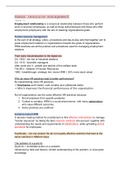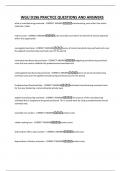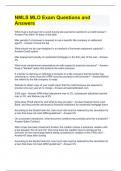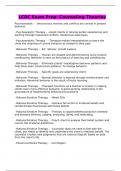(week 1)
Employment relationship is a reciprocal relationship between those who perform
work or services (employees, as well as those self-employed) and those who offer
employment (employers) with the aim of realizing organizational goals.
Human resource management
Is the sum of all strategy, policy, procedures and day-to-day acts that together aim to
guide employment relations in organizations towards the goals of organizations.
HRM practices are all the policies and procedures used for managing employment
relations.
From early industrialization to the digital era
CA. 1900 - the rise of industrial relations
CA. 1910 - Scientific managent
After world war II - growth and decline of the welfare state
The 80’s - initiation of Human Resources
1995 - breakthrough: strategic hrm (more HRM = 20% more stock value)
Why do more HR practices lead to better performance?
By implementing more HR practices
→ Employees work harder, work smarter and collaborate better
→ Which improves the financial performance of the organization
Not all organizations use the same effective HR practices because:
1. Not all practices fit for specific problems
2. Context is complex, HRM is a social phenomenon, with many stakeholders,
who value different outcomes.
3. Some practices are unethical
Evidence-based HRM
A decision-making method for practitioners to find effective interventions to manage
“human resources” by taking the best research evidence into account, together with
understanding the needs and requirements of stakeholders, while upholding ethical
standards for employees.
Equifinality - not one solution fits all, but equally effective solutions that lead to the
same outcome in different ways.
The problem of a quick fix
Quick fix = immediate action on a problem.
Influenced by fads and fashion, limited understanding of the problem, or inaccurate
knowledge.
,Motivated by organizational politics and self-interest
Not evaluated, often followed by another quick fix.
Quick fixes harm organizations and employees!
Slow fix
A slower fix means a more sustainable solution.
By using evidence (which can be found in a library of research overviews), such as
systematic reviews or meta-analyses, in your fix, you can improve it.
Center for evidence-based management.
EB-HRM is a conscientious, explicit and judicious decision-making process to
address important people-related issues in organizations by combining the best
available research evidence with measurable data and professional knowledge
available in organizations.
- A method for practitioners who consciously apply their expertise and
judgment;
- Who use evidence from the local context to which the decision applies;
- Who critically evaluate of the best available external research evidence;
- And who take perspectives of people who are affected by the decision into
account.
A decision-making flowchart
Step 5: Evaluate the evidence
Validity:
- The evidence helps you understand the cause of the problem
- Implication: Ask the right questions to the right sources (people, data)
- Check the quality of measures, research design and use good theory
, Reliability:
- The findings reported in the evidence would be similar if we replicated the
research.
- The findings would be the same if we asked someone else (sample size)
Generalizability:
- We can use this evidence to say something about the targeted employees for
the problem intervention
Ethicality:
- Do no harm!
Benefits of evidence-based HRM
1. A better understanding of problems in the organization.
2. A culture of learning and curiosity
3. Cumulative availability of data (evidence) to use (HR analytics)
4. Reduction of organizational politics
When is EB-HRM not useful?
Arguable:
In common, day-to-day management decisions.
In crisis situations
However:
Cumulative EB-HRM knowledge will improve decision-making on a day-to-day basis
and during crises.
A culture of evidence and evaluation will improve organizational learning.
Conclusion
EB-HRM is a procedure to overcome bounded rationality and improve decisions
about people in workplaces.
Practising EB-HRM leads to more effective HR practices
It also contributes to an organizational culture of learning and knowledge sharing.
This will also improve decision-making on a daily basis and during crises.
(week 2)
Reducing production costs increases performance.
But low labour costs aren’t necessarily beneficial.
High wages and benefits
cause low employee turnover and high employee productivity, which is positive.
Low wages and benefits
cause high employee turnover and low employee productivity, which is negative






